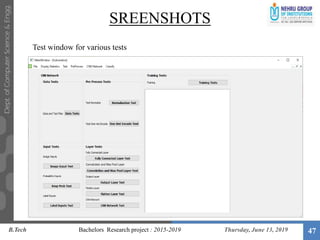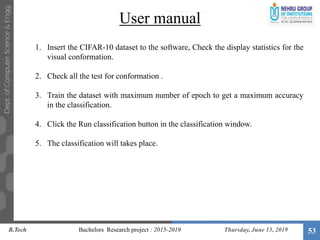Image classification using convolutional neural network
- 1. 1 Guided By : Mr. MANOJ M ASSISTANT PROFESSOR COMPUTER SCIENCE Presented By : ABDUL MANAF KIRAN R PIOUS PAUL VISHNU P.S IMAGE CLASSIFICATION USING CONVOLUTIONAL NEURAL NETWORK B.Tech Bachelors Research project : 2015-2019 Thursday, June 13, 2019
- 2. 2 Image classification model using a convolutional neural network with Tensor Flow. A multi-category image data set has been considered for the classification. The classifier train this proposed classifier to calculate the decision boundary of the image dataset. The data in the real world is mostly in the form of unlabeled and unstructured format. These unstructured images are need to be classified . Thus CNN is introduced for image classification. ABSTRACT B.Tech Bachelors Research project : 2015-2019 Thursday, June 13, 2019
- 3. 3 OBJECTIVE To classify the images according to the category which belong from a large set of different images from different categories . Sort the image in separate folders according to their names. B.Tech Bachelors Research project : 2015-2019 Thursday, June 13, 2019
- 4. 4 Image classification plays an important role in computer vision, it has a very important significance in our study, work and life.[4] Image classification is process including image preprocessing, image segmentation, key feature extraction and matching identification. With the latest figures image classification techniques, we not only get the picture information faster than before, we apply it to scientific experiments. INTRODUCTION B.Tech Bachelors Research project : 2015-2019 Thursday, June 13, 2019 [4] Krizhevsky A, Sutskever I, Hinton G E. ImageNet Classification with Deep Convolutional Neural Networks[J]. Advances in Neural Information Processing Systems, 2012, 25(2):2012.
- 5. 5 [10] Xavier Mu ̃nozComputer Vision GroupUniversity of Gironaxmunoz@eia.udg.es, Anna BoschComputer Vision GroupUniversity of Gironaaboschr@eia.udg.es,Image Classification using Random Forests and Ferns. Image classification using SUPPORT VECTOR MACHINE , RANDOM FOREST algorithm which is available on online platforms.[10] • These algorithms are highly complicated and time consuming for processing and classifying images. • Several key parameters should be correctly set to achieve best classification result. Existing system B.Tech Bachelors Research project : 2015-2019 Thursday, June 13, 2019
- 6. PROPOSED SYSTEM Thursday, June 13, 2019 6 An image classifier using convolutional neural network,which use CIFAR-10 dataset for image classification. Classifies the images with more accuracy. Classifies and save the images in separate folders according to the class it goes. B.Tech Bachelors Research project : 2015-2019
- 7. 7 LITERATURE REVIEW DEEP LEARNING AND IMAGE CLASSIFICATION Deep learning is part of a broader family of machine learning methods based on the layers used in artificial neural networks.[4] . B.Tech Bachelors Research project : 2015-2019 Thursday, June 13, 2019 [4] Krizhevsky A, Sutskever I, Hinton G E. ImageNet Classification with Deep Convolutional Neural Networks[J]. Advances in Neural Information Processing Systems, 2012, 25(2):2012.
- 8. 8 LITERATURE REVIEW Convolutional neural network Convolutional neural network is one of the main categories to do images recognition, images classifications. Objects detections, recognition faces etc.[6] It has 5 layers. 1. Input layer 2. Convolutional layer 3. Pooling layer 4. Fully connected layer. 5. Output layer. B.Tech Bachelors Research project : 2015-2019 Thursday, June 13, 2019 [6] N. Kalchbrenner, E. Grefenstette, and P. Blunsom, “A convolutional neural network for modelling sentences,” arXiv preprint arXiv:1404.2188, 2014.
- 9. 9 LITERATURE REVIEW CNN TRAINING A part of data set is given to the training process of the network [11]. Training process is the state at which the network is learning the training data. The training data set is used to train the network. After completing training a model is created. [11] Image Classification via Support Vector Machine Xiaowu Sun1, Lizhen Liu1, Hanshi Wang1, Wei Song1, Jingli Lu2 1 Information and Engineering College, Capital Normal University, Beijing 100048, P. R. China 2 Agresearch Ltd, New Zealand B.Tech Bachelors Research project : 2015-2019 Thursday, June 13, 2019
- 10. 10 LITERATURE REVIEW EPOCH An epoch is one complete presentation of the data set to be learned to a learning machine.[11] B.Tech Bachelors Research project : 2015-2019 Thursday, June 13, 2019 [11] Image Classification via Support Vector Machine Xiaowu Sun1, Lizhen Liu1, Hanshi Wang1, Wei Song1, Jingli Lu2 1 Information and Engineering College, Capital Normal University, Beijing 100048, P. R. China 2 Agresearch Ltd, New Zealand
- 11. 11 LITERATURE REVIEW CNN MODEL A model is generated after the training of the CNN[11]. A pre-trained model is a model that was trained on a large benchmark dataset to solve a problem similar to the one that we want to solve. B.Tech Bachelors Research project : 2015-2019 Thursday, June 13, 2019 [11] Image Classification via Support Vector Machine Xiaowu Sun1, Lizhen Liu1, Hanshi Wang1, Wei Song1, Jingli Lu2 1 Information and Engineering College, Capital Normal University, Beijing 100048, P. R. China 2 Agresearch Ltd, New Zealand
- 12. 12 LITERATURE REVIEW CNN TESTING In this stage the performance of the network is measured.[13] The test dataset is used for the testing Accuracy is the closeness of actual output and desired output Error is the variation in between the actual output and desired output In deep learning, a convolutional neural network is a class of deep neural network. B.Tech Bachelors Research project : 2015-2019 Thursday, June 13, 2019 [13] Impact of Training and Testing Data Splits on Accuracy of Time Series Forecasting in Machine Learning Ramesh Medar Vijay S. Rajpurohit-Rashmi. B.
- 13. 13 LITERATURE REVIEW DATA SET A collection of images in various categories with meta data[13]. It contains training and testing data. Image dataset may consist of full of images and its .csv files. B.Tech Bachelors Research project : 2015-2019 Thursday, June 13, 2019 [13] Impact of Training and Testing Data Splits on Accuracy of Time Series Forecasting in Machine Learning Ramesh Medar Vijay S. Rajpurohit-Rashmi. B.
- 14. 14 LITERATURE REVIEW CIFAR-10 The CIFAR-10 dataset consists of 60000 32x32 color images in 10 classes, with 6000 images per class. There are 50000 training images and 10000 test images.[14] The dataset is divided into five training batches and one test batch, each with 10000 images. The test batch contains exactly 1000 randomly-selected images from each class. The training batches contain the remaining images in random order, but some training batches may contain more images from one class than another. Between them, the training batches contain exactly 5000 images from each class. B.Tech Bachelors Research project : 2015-2019 Thursday, June 13, 2019 [14] Preprocessing for Image Classification by Convolutional Neural Networks Kuntal Kumar Pal, Sudeep K. S IEEE International Conference On Recent Trends In Electronics Information Communication Technology, May 20-21, 2016, India
- 15. 15 LITERATURE REVIEW Here are the classes in the dataset, as well as 10 random images from each: . B.Tech Bachelors Research project : 2015-2019 Thursday, June 13, 2019 [14] Preprocessing for Image Classification by Convolutional Neural Networks Kuntal Kumar Pal, Sudeep K. S IEEE International Conference On Recent Trends In Electronics Information Communication Technology, May 20-21, 2016, India
- 16. 16 LITERATURE REVIEW FEATURE MAP The feature map is the output of one filter applied to the previous layer. A given filter is drawn across the entire previous layer, moved one pixel at a time.[14] Each position results in an activation of the neuron and the output is collected in the feature map. B.Tech Bachelors Research project : 2015-2019 Thursday, June 13, 2019 [14] Preprocessing for Image Classification by Convolutional Neural Networks Kuntal Kumar Pal, Sudeep K. S IEEE International Conference On Recent Trends In Electronics Information Communication Technology, May 20-21, 2016, India
- 17. 17 LITERATURE REVIEW PREPROCESSING Raw data if applied to any classification methods does not produce good accuracy as can be verified from the results we achieved.[14] The goal is to show how much the accuracy varies with the application of some well-known preprocessing techniques on some simple convolutional networks. B.Tech Bachelors Research project : 2015-2019 Thursday, June 13, 2019 [14] Preprocessing for Image Classification by Convolutional Neural Networks Kuntal Kumar Pal, Sudeep K. S IEEE International Conference On Recent Trends In Electronics Information Communication Technology, May 20-21, 2016, India
- 18. 18 LITERATURE REVIEW NORMALIZATION Normalization is a technique often applied as part of data preparation for machine learning. B.Tech Bachelors Research project : 2015-2019 Thursday, June 13, 2019 [14] Preprocessing for Image Classification by Convolutional Neural Networks Kuntal Kumar Pal, Sudeep K. S IEEE International Conference On Recent Trends In Electronics Information Communication Technology, May 20-21, 2016, India
- 19. 19 SYSTEM ARCHITECTURE B.Tech Bachelors Research Project: 2015-2019 MODULE DESCRIPTION 1. INPUT 2. TRAINING 3. CLASSIFICATION Thursday, June 13, 2019
- 20. 20 SYSTEM ARCHITECTURE B.Tech Bachelors Research Project: 2015-2019 MODULE DESCRIPTION Thursday, June 13, 2019 Block diagram
- 21. 21 SYSTEM ARCHITECTURE B.Tech Bachelors Research Project: 2015-2019 Thursday, June 13, 2019
- 22. 22 SYSTEM ARCHITECTURE B.Tech Bachelors Research Project: 2015-2019 MODULE 1 Input image Computers sees an input image as array of pixels and it depends on the image resolution. Based on the image resolution, it will see h x w x d( h = Height, w = Width, d = Dimension) Thursday, June 13, 2019
- 23. 23 SYSTEM ARCHITECTURE B.Tech Bachelors Research Project: 2015-2019 An image of 6 x 6 x 3 array of matrix of RGB (3 refers to RGB values) Thursday, June 13, 2019
- 24. 24 SYSTEM ARCHITECTURE B.Tech Bachelors Research Project: 2015-2019 MODULE 2 CONVOLUTIONAL LAYER Convolution is the first layer to extract features from an input image. Convolution preserves the relationship between pixels by learning image features using small squares of input data. It is a mathematical operation that takes two inputs such as image matrix and a filter or kernal. Thursday, June 13, 2019
- 25. 25 SYSTEM ARCHITECTURE B.Tech Bachelors Research Project: 2015-2019 Thursday, June 13, 2019
- 26. SYSTEM ARCHITECTURE The convolution of 5 x 5 image matrix multiplies with 3 x 3 filter matrix which is called “Feature Map”
- 27. 27 SYSTEM ARCHITECTURE B.Tech Bachelors Research Project: 2015-2019 Thursday, June 13, 2019
- 28. 28 SYSTEM ARCHITECTURE B.Tech Bachelors Research Project: 2015-2019 PADDING Sometimes filter does not fit perfectly fit the input image. We have two options: Pad the picture with zeros (zero-padding) so that it fits Drop the part of the image where the filter did not fit. This is called valid padding which keeps only valid part of the image. Thursday, June 13, 2019
- 29. 29 SYSTEM ARCHITECTURE B.Tech Bachelors Research Project: 2015-2019 NON LINEARITY (RELU) ReLU stands for Rectified Linear Unit for a non-linear operation. The output is ƒ(x) = max(0,x). Why ReLU is important : ReLU’s purpose is to introduce non- linearity in our ConvNet. Since, the real world data would want our ConvNet to learn would be non-negative linear values. Thursday, June 13, 2019
- 30. 30 SYSTEM ARCHITECTURE B.Tech Bachelors Research Project: 2015-2019 RELU OPERATION Thursday, June 13, 2019
- 31. 31 SYSTEM ARCHITECTURE B.Tech Bachelors Research Project: 2015-2019 POOLING LAYER Pooling layers section would reduce the number of parameters when the images are too large. Pooling layer consider a block of input data and simply pass on maximum value Hence it reduces the size of the input and require no added parameters Thursday, June 13, 2019
- 32. 32 SYSTEM ARCHITECTURE B.Tech Bachelors Research Project: 2015-2019 FLATTENING After finishing the previous two steps, we're supposed to have a pooled feature map by now. As the name of this step implies, we are literally going to flatten our pooled feature map into a column like in the image below. Thursday, June 13, 2019 MODULE 3
- 33. 39 SYSTEM ARCHITECTURE B.Tech Bachelors Research Project: 2015-2019 FLATTENING The reason we do this is that we're going to need to insert this data into an artificial neural network later on. Thursday, June 13, 2019
- 34. 34 SYSTEM ARCHITECTURE B.Tech Bachelors Research Project: 2015-2019 FULLY CONNECTED LAYER The layer we call as FC layer, we flattened our matrix into vector and feed it into a fully connected layer like neural network. Thursday, June 13, 2019
- 35. 35 SYSTEM ARCHITECTURE B.Tech Bachelors Research Project: 2015-2019 Fully connected layer is connected with output layer Thursday, June 13, 2019
- 36. 36 SYSTEM ARCHITECTURE B.Tech Bachelors Research Project: 2015-2019 Thursday, June 13, 2019 SOFTMAX FUCTION Activation function used in the cnn.
- 37. 37 SYSTEM ARCHITECTURE B.Tech Bachelors Research Project: 2015-2019 Thursday, June 13, 2019 Output layer After multiple layers of convolution and padding. output should be in the form of a class. The convolution and pooling layers would only be able to extract features and reduce the number of parameters from the original images. However, to generate the final output we need to apply a fully connected layer to generate an output equal to the number of classes we need. Thus the output layer give the classified images.
- 38. Obtained outcome • Image which are classified with its name. • The probability of image to be in the other class. Thursday, June 13, 2019 38B.Tech Main Project : 2009-2013
- 39. CONCLUSION AND FUTURE SCOPE Thursday, June 13, 2019 39 FUTURE SCOPE Image can be classified and keep in separate folders. Automatic face recognition and object recognition can be used for classifying the images automatically. B.Tech Bachelors Research project : 2015-2019 Implemented an image classifier using convolutional neural network, which is more efficient for image classification when comparing to the other methods. It is usefully for classifying larger number of image with in short time.
- 40. Thursday, June 13, 2019 40 HARDWARE REQUIREMENT Operating system: windows 8 or later. PROCESSOR : Intel i3 6th gen or later RAM : MIN 2 GB HDD : MIN 40 GB B.Tech Bachelors Research project : 2015-2019
- 41. Thursday, June 13, 2019 41 SOFTWARE REQUIREMENT Progamming language : Python 3.7 Framework : Spyder 3.3.3 Software library : Google tensor flow Development environment : Anaconda For visualization : matplotlib B.Tech Bachelors Research project : 2015-2019
- 42. REFERENCES Thursday, June 13, 2019 42 [1] A.LecunY, Bottou L, Bengio Y, et al. Gradient-based learning appliedto document recognition[J]. Proceedings of the IEEE, 1998,86(11):2278-2324. [2] Cun Y L, Boser B, Denker J S, et al. Handwritten digit recognition with a back-propagation network[C] Advances in Neural Information Processing Systems. Morgan Kaufmann Publishers Inc. [3] Hecht-Nielsen R. Theory of the backpropagation neural network[M] Neural networks for perception (Vol. 2). Harcourt Brace & Co. 1992:593-605 vol.1. [4] Krizhevsky A, Sutskever I, Hinton G E. ImageNet Classification with Deep Convolutional Neural Networks[J]. Advances in Neural Information Processing Systems, 2012, 25(2):2012. [5] M. D. Zeiler and R. Fergus, “Visualizing and understanding convolutional networks,” in ECCV, 2014. B.Tech Bachelors Research project : 2015-2019
- 43. REFERENCES [6] N. Kalchbrenner, E. Grefenstette, and P. Blunsom, “A convolutional neural network for modelling sentences,” arXiv preprint arXiv:1404.2188, 2014. [7] O. Abdel-Hamid, A. R. Mohamed, H. Jiang, and G. Penn, “Applying convolutional neural networks concepts to hybrid nn-hmm model for speech recognition,” in Acoustics, Speech and Signal Processing (ICASSP), 2012 IEEE International Conference on. IEEE, 2012, pp. 4277–4280. [8] Y. LeCun, B. Boser, J. S. Denker, D. Henderson, R. E. Howard, W. Hubbard, and L. D. Jackel, “Backpropagation applied to handwritten zip code recognition,” Neural computation, vol. 1, no. 4, pp. 541–551, 1989. [9] Y. LeCun, L. Bottou, Y. Bengio, and P. Haffner, “Gradient-based learning applied to document recognition,” Proceedings of the IEEE, vol. 86, no. 11, pp. 2278–2324, 1998. [10]Xavier Mu ̃nozComputer Vision GroupUniversity of Gironaxmunoz@eia.udg.es, Anna BoschComputer Vision GroupUniversity of Gironaaboschr@eia.udg.es,Image Classification using Random Forests and Ferns. Thursday, June 13, 2019 43B.Tech Bachelors Research project : 2015-2019
- 44. REFERENCES [11] Image Classification via Support Vector Machine Xiaowu Sun1, Lizhen Liu1, Hanshi Wang1, Wei Song1, Jingli Lu2 1 Information and Engineering College, Capital Normal University, Beijing 100048, P. R. China 2 Agresearch Ltd, New Zealand [12]Unsupervised Deep Feature Extraction for Remote Sensing Image Classification Adriana Romero, Carlo Gatta, and Gustau Camps-Valls, Senior Member, IEEE. Thursday, June 13, 2019 44B.Tech Bachelors Research project : 2015-2019 [13] Impact of Training and Testing Data Splits on Accuracy of Time Series Forecasting in Machine Learning Ramesh Medar Vijay S. Rajpurohit Rashmi B. [14] Preprocessing for Image Classification by Convolutional Neural Networks Kuntal Kumar Pal, Sudeep K. S IEEE International Conference On Recent Trends In Electronics Information Communication Technology, May 20-21, 2016, India. .
- 45. SREENSHOTS Thursday, June 13, 2019 45 Main window : used to give dataset input B.Tech Bachelors Research project : 2015-2019
- 46. SREENSHOTS Thursday, June 13, 2019 46 Display statistics B.Tech Bachelors Research project : 2015-2019
- 47. SREENSHOTS Thursday, June 13, 2019 47 Test window for various tests B.Tech Bachelors Research project : 2015-2019
- 48. SREENSHOTS Thursday, June 13, 2019 48 Preprocessing B.Tech Bachelors Research project : 2015-2019
- 49. SREENSHOTS Thursday, June 13, 2019 49 CNN training window B.Tech Bachelors Research project : 2015-2019
- 50. SREENSHOTS Thursday, June 13, 2019 50 Classification result of 2 epoch training B.Tech Bachelors Research project : 2015-2019
- 51. SREENSHOTS Thursday, June 13, 2019 51 Classification result of 10 epoch training B.Tech Bachelors Research project : 2015-2019
- 52. SREENSHOTS Thursday, June 13, 2019 52 Classification result of 75 epoch training B.Tech Bachelors Research project : 2015-2019
- 53. User manual Thursday, June 13, 2019 53 1. Insert the CIFAR-10 dataset to the software, Check the display statistics for the visual conformation. 2. Check all the test for conformation . 3. Train the dataset with maximum number of epoch to get a maximum accuracy in the classification. 4. Click the Run classification button in the classification window. 5. The classification will takes place. B.Tech Bachelors Research project : 2015-2019
- 54. Thank You Thursday, June 13, 2019 54B.Tech Bachelors Research Project : 2015-2019
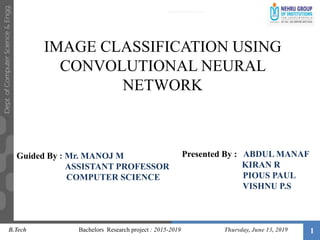
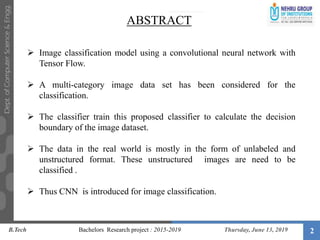
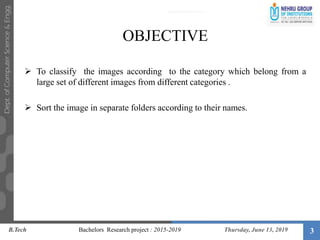
![4
Image classification plays an important role in computer vision, it has a
very important significance in our study, work and life.[4]
Image classification is process including image preprocessing, image
segmentation, key feature extraction and matching identification.
With the latest figures image classification techniques, we not only get
the picture information faster than before, we apply it to scientific
experiments.
INTRODUCTION
B.Tech Bachelors Research project : 2015-2019 Thursday, June 13, 2019
[4] Krizhevsky A, Sutskever I, Hinton G E. ImageNet Classification with Deep Convolutional Neural Networks[J]. Advances in Neural Information
Processing Systems, 2012, 25(2):2012.](https://image.slidesharecdn.com/imageclassificationusingconvolutionalneuralnetwork-190613032757/85/Image-classification-using-convolutional-neural-network-4-320.jpg)
![5
[10] Xavier Mu ̃nozComputer Vision GroupUniversity of Gironaxmunoz@eia.udg.es, Anna BoschComputer Vision
GroupUniversity of Gironaaboschr@eia.udg.es,Image Classification using Random Forests and Ferns.
Image classification using SUPPORT VECTOR MACHINE ,
RANDOM FOREST algorithm which is available on online
platforms.[10]
• These algorithms are highly complicated and time consuming for
processing and classifying images.
• Several key parameters should be correctly set to achieve best
classification result.
Existing system
B.Tech Bachelors Research project : 2015-2019 Thursday, June 13, 2019](https://image.slidesharecdn.com/imageclassificationusingconvolutionalneuralnetwork-190613032757/85/Image-classification-using-convolutional-neural-network-5-320.jpg)

![7
LITERATURE REVIEW
DEEP LEARNING AND IMAGE CLASSIFICATION
Deep learning is part of a broader family of machine learning methods
based on the layers used in artificial neural networks.[4]
.
B.Tech Bachelors Research project : 2015-2019 Thursday, June 13, 2019
[4] Krizhevsky A, Sutskever I, Hinton G E. ImageNet Classification with Deep Convolutional Neural Networks[J]. Advances in Neural Information
Processing Systems, 2012, 25(2):2012.](https://image.slidesharecdn.com/imageclassificationusingconvolutionalneuralnetwork-190613032757/85/Image-classification-using-convolutional-neural-network-7-320.jpg)
![8
LITERATURE REVIEW
Convolutional neural network
Convolutional neural network is one of the main categories to do images
recognition, images classifications. Objects detections, recognition faces etc.[6]
It has 5 layers.
1. Input layer
2. Convolutional layer
3. Pooling layer
4. Fully connected layer.
5. Output layer.
B.Tech Bachelors Research project : 2015-2019 Thursday, June 13, 2019
[6] N. Kalchbrenner, E. Grefenstette, and P. Blunsom, “A convolutional neural network for modelling sentences,” arXiv preprint
arXiv:1404.2188, 2014.](https://image.slidesharecdn.com/imageclassificationusingconvolutionalneuralnetwork-190613032757/85/Image-classification-using-convolutional-neural-network-8-320.jpg)
![9
LITERATURE REVIEW
CNN TRAINING
A part of data set is given to the training process of the network [11].
Training process is the state at which the network is learning the
training data.
The training data set is used to train the network. After completing
training a model is created.
[11] Image Classification via Support Vector Machine Xiaowu Sun1, Lizhen Liu1, Hanshi Wang1, Wei Song1, Jingli Lu2 1 Information
and Engineering College, Capital Normal University, Beijing 100048, P. R. China 2 Agresearch Ltd, New Zealand
B.Tech Bachelors Research project : 2015-2019 Thursday, June 13, 2019](https://image.slidesharecdn.com/imageclassificationusingconvolutionalneuralnetwork-190613032757/85/Image-classification-using-convolutional-neural-network-9-320.jpg)
![10
LITERATURE REVIEW
EPOCH
An epoch is one complete presentation of the data set to be learned to a
learning machine.[11]
B.Tech Bachelors Research project : 2015-2019 Thursday, June 13, 2019
[11] Image Classification via Support Vector Machine Xiaowu Sun1, Lizhen Liu1, Hanshi Wang1, Wei Song1, Jingli Lu2 1 Information and
Engineering College, Capital Normal University, Beijing 100048, P. R. China 2 Agresearch Ltd, New Zealand](https://image.slidesharecdn.com/imageclassificationusingconvolutionalneuralnetwork-190613032757/85/Image-classification-using-convolutional-neural-network-10-320.jpg)
![11
LITERATURE REVIEW
CNN MODEL
A model is generated after the training of the CNN[11].
A pre-trained model is a model that was trained on a large benchmark
dataset to solve a problem similar to the one that we want to solve.
B.Tech Bachelors Research project : 2015-2019 Thursday, June 13, 2019
[11] Image Classification via Support Vector Machine Xiaowu Sun1, Lizhen Liu1, Hanshi Wang1, Wei Song1, Jingli Lu2 1 Information and
Engineering College, Capital Normal University, Beijing 100048, P. R. China 2 Agresearch Ltd, New Zealand](https://image.slidesharecdn.com/imageclassificationusingconvolutionalneuralnetwork-190613032757/85/Image-classification-using-convolutional-neural-network-11-320.jpg)
![12
LITERATURE REVIEW
CNN TESTING
In this stage the performance of the network is measured.[13]
The test dataset is used for the testing
Accuracy is the closeness of actual output and desired output
Error is the variation in between the actual output and desired output
In deep learning, a convolutional neural network is a class of deep neural network.
B.Tech Bachelors Research project : 2015-2019 Thursday, June 13, 2019
[13] Impact of Training and Testing Data Splits on Accuracy of Time Series Forecasting in Machine Learning Ramesh Medar Vijay S.
Rajpurohit-Rashmi. B.](https://image.slidesharecdn.com/imageclassificationusingconvolutionalneuralnetwork-190613032757/85/Image-classification-using-convolutional-neural-network-12-320.jpg)
![13
LITERATURE REVIEW
DATA SET
A collection of images in various categories with meta data[13].
It contains training and testing data.
Image dataset may consist of full of images and its .csv files.
B.Tech Bachelors Research project : 2015-2019 Thursday, June 13, 2019
[13] Impact of Training and Testing Data Splits on Accuracy of Time Series Forecasting in Machine Learning Ramesh Medar Vijay S.
Rajpurohit-Rashmi. B.](https://image.slidesharecdn.com/imageclassificationusingconvolutionalneuralnetwork-190613032757/85/Image-classification-using-convolutional-neural-network-13-320.jpg)
![14
LITERATURE REVIEW
CIFAR-10
The CIFAR-10 dataset consists of 60000 32x32 color images in 10 classes,
with 6000 images per class. There are 50000 training images and 10000 test
images.[14]
The dataset is divided into five training batches and one test batch, each with
10000 images.
The test batch contains exactly 1000 randomly-selected images from each
class.
The training batches contain the remaining images in random order, but
some training batches may contain more images from one class than another.
Between them, the training batches contain exactly 5000 images from each
class.
B.Tech Bachelors Research project : 2015-2019 Thursday, June 13, 2019
[14] Preprocessing for Image Classification by Convolutional Neural Networks Kuntal Kumar Pal, Sudeep K. S IEEE International
Conference On Recent Trends In Electronics Information Communication Technology, May 20-21, 2016, India](https://image.slidesharecdn.com/imageclassificationusingconvolutionalneuralnetwork-190613032757/85/Image-classification-using-convolutional-neural-network-14-320.jpg)
![15
LITERATURE REVIEW
Here are the classes in the dataset, as well as 10 random images from each:
.
B.Tech Bachelors Research project : 2015-2019 Thursday, June 13, 2019
[14] Preprocessing for Image Classification by Convolutional Neural Networks Kuntal Kumar Pal, Sudeep K. S IEEE International
Conference On Recent Trends In Electronics Information Communication Technology, May 20-21, 2016, India](https://image.slidesharecdn.com/imageclassificationusingconvolutionalneuralnetwork-190613032757/85/Image-classification-using-convolutional-neural-network-15-320.jpg)
![16
LITERATURE REVIEW
FEATURE MAP
The feature map is the output of one filter applied to the previous layer.
A given filter is drawn across the entire previous layer, moved one pixel at
a time.[14]
Each position results in an activation of the neuron and the output is
collected in the feature map.
B.Tech Bachelors Research project : 2015-2019 Thursday, June 13, 2019
[14] Preprocessing for Image Classification by Convolutional Neural Networks Kuntal Kumar Pal, Sudeep K. S IEEE International
Conference On Recent Trends In Electronics Information Communication Technology, May 20-21, 2016, India](https://image.slidesharecdn.com/imageclassificationusingconvolutionalneuralnetwork-190613032757/85/Image-classification-using-convolutional-neural-network-16-320.jpg)
![17
LITERATURE REVIEW
PREPROCESSING
Raw data if applied to any classification methods does not produce good
accuracy as can be verified from the results we achieved.[14]
The goal is to show how much the accuracy varies with the application of
some well-known preprocessing techniques on some simple convolutional
networks.
B.Tech Bachelors Research project : 2015-2019 Thursday, June 13, 2019
[14] Preprocessing for Image Classification by Convolutional Neural Networks Kuntal Kumar Pal, Sudeep K. S IEEE International
Conference On Recent Trends In Electronics Information Communication Technology, May 20-21, 2016, India](https://image.slidesharecdn.com/imageclassificationusingconvolutionalneuralnetwork-190613032757/85/Image-classification-using-convolutional-neural-network-17-320.jpg)
![18
LITERATURE REVIEW
NORMALIZATION
Normalization is a technique often applied as part of data preparation for machine
learning.
B.Tech Bachelors Research project : 2015-2019 Thursday, June 13, 2019
[14] Preprocessing for Image Classification by Convolutional Neural Networks Kuntal Kumar Pal, Sudeep K. S IEEE International
Conference On Recent Trends In Electronics Information Communication Technology, May 20-21, 2016, India](https://image.slidesharecdn.com/imageclassificationusingconvolutionalneuralnetwork-190613032757/85/Image-classification-using-convolutional-neural-network-18-320.jpg)







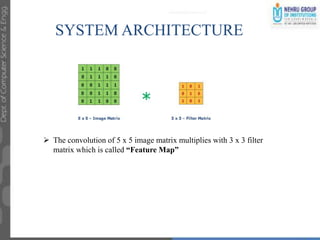



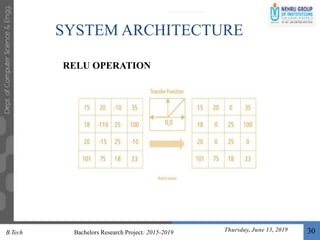











![REFERENCES
Thursday, June 13, 2019 42
[1] A.LecunY, Bottou L, Bengio Y, et al. Gradient-based learning appliedto
document recognition[J]. Proceedings of the IEEE, 1998,86(11):2278-2324.
[2] Cun Y L, Boser B, Denker J S, et al. Handwritten digit recognition with a
back-propagation network[C] Advances in Neural Information Processing
Systems. Morgan Kaufmann Publishers Inc.
[3] Hecht-Nielsen R. Theory of the backpropagation neural network[M] Neural
networks for perception (Vol. 2). Harcourt Brace & Co.
1992:593-605 vol.1.
[4] Krizhevsky A, Sutskever I, Hinton G E. ImageNet Classification with Deep
Convolutional Neural Networks[J]. Advances in Neural Information Processing
Systems, 2012, 25(2):2012.
[5] M. D. Zeiler and R. Fergus, “Visualizing and understanding convolutional
networks,” in ECCV, 2014.
B.Tech Bachelors Research project : 2015-2019](https://image.slidesharecdn.com/imageclassificationusingconvolutionalneuralnetwork-190613032757/85/Image-classification-using-convolutional-neural-network-42-320.jpg)
![REFERENCES
[6] N. Kalchbrenner, E. Grefenstette, and P. Blunsom, “A convolutional neural network
for modelling sentences,” arXiv preprint arXiv:1404.2188, 2014.
[7] O. Abdel-Hamid, A. R. Mohamed, H. Jiang, and G. Penn, “Applying convolutional
neural networks concepts to hybrid nn-hmm model for speech recognition,” in
Acoustics, Speech and Signal Processing (ICASSP), 2012 IEEE International
Conference on. IEEE, 2012, pp. 4277–4280.
[8] Y. LeCun, B. Boser, J. S. Denker, D. Henderson, R. E. Howard, W. Hubbard, and L.
D. Jackel, “Backpropagation applied to handwritten zip code recognition,” Neural
computation, vol. 1, no. 4, pp. 541–551, 1989.
[9] Y. LeCun, L. Bottou, Y. Bengio, and P. Haffner, “Gradient-based learning applied to
document recognition,” Proceedings of the IEEE, vol. 86, no. 11, pp. 2278–2324, 1998.
[10]Xavier Mu ̃nozComputer Vision GroupUniversity of Gironaxmunoz@eia.udg.es,
Anna BoschComputer Vision GroupUniversity of Gironaaboschr@eia.udg.es,Image
Classification using Random Forests and Ferns.
Thursday, June 13, 2019 43B.Tech Bachelors Research project : 2015-2019](https://image.slidesharecdn.com/imageclassificationusingconvolutionalneuralnetwork-190613032757/85/Image-classification-using-convolutional-neural-network-43-320.jpg)
![REFERENCES
[11] Image Classification via Support Vector Machine Xiaowu Sun1, Lizhen Liu1,
Hanshi Wang1, Wei Song1, Jingli Lu2 1 Information and Engineering College, Capital
Normal University, Beijing 100048, P. R. China 2 Agresearch Ltd, New Zealand
[12]Unsupervised Deep Feature Extraction for Remote Sensing Image Classification
Adriana Romero, Carlo Gatta, and Gustau Camps-Valls, Senior Member, IEEE.
Thursday, June 13, 2019 44B.Tech Bachelors Research project : 2015-2019
[13] Impact of Training and Testing Data Splits on Accuracy of Time Series Forecasting
in Machine Learning Ramesh Medar Vijay S. Rajpurohit Rashmi B.
[14] Preprocessing for Image Classification by Convolutional Neural Networks Kuntal
Kumar Pal, Sudeep K. S IEEE International Conference On Recent Trends In
Electronics Information Communication Technology, May 20-21, 2016, India.
.](https://image.slidesharecdn.com/imageclassificationusingconvolutionalneuralnetwork-190613032757/85/Image-classification-using-convolutional-neural-network-44-320.jpg)


